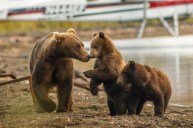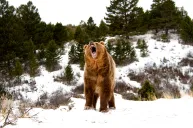A video circulating the internet tells the story of the unluckiest bear in the world. Because of its white fur, the albino grizzly bear's life plays out much like a comedy of errors. Since 2021, scientists have repeatedly mistaken it for a polar bear and then relocated it from its natural habitat in North America to the Arctic. The narrative is a hilarious series of unfortunate events but ultimately too good to be true.
Bears Come In Many Colors
According to the fact-checking website Snopes, researchers "did not find any credible reports to corroborate the tale." Experts like Geoff York, a director with Polar Bears International who called the story a "spoof," told the website that two things stand out.
First, the bear in the video is "clearly not a polar bear." Second, grizzly and black bears come in a variety of colors, ranging from black and brown to cinnamon, blond, blue-gray, and even white. Their color often depends on their genetics as well as their location.
For instance, scientists explained that the famous grizzly known as Nakoda, who died in a car accident last month, had white fur caused by a recessive gene rather than albinism. And while grizzly and polar bears occasionally interact (and even breed), it's rare and caused because of the polar bear's shrinking habitat. Plus, polar bears are on average much bigger than grizzlies.
Transporting 'Unluckiest Bear' Is Too Difficult
What's more, relocating the bear from North America to the Arctic is just unrealistic from a coordination and resources standpoint. "Broadly speaking, animal welfare groups do not engage in relocation efforts and typically lack the management authority and funding necessary to capture and transport animals nationally, let alone across international borders," York said. He added transporting anything to the North Pole is also extremely expensive and difficult. "It is among the last places you would attempt to re-home anything," he said.
While it's unclear where the video originated, it's been circulating and repackaged on social media at least since 2023. The countless videos on platforms like TikTok and Instagram have millions of views and shares with little to no fact checking — or maybe they just didn't watch it to the end.




